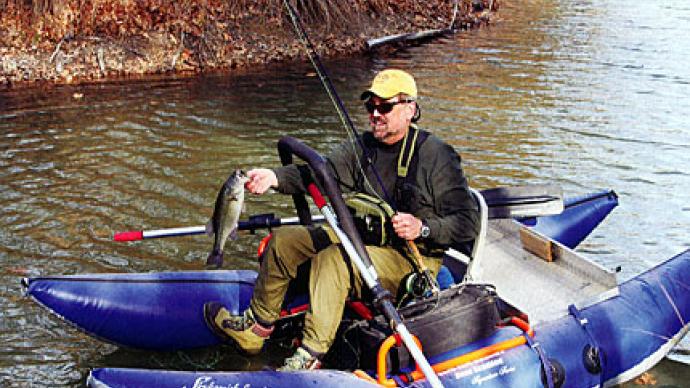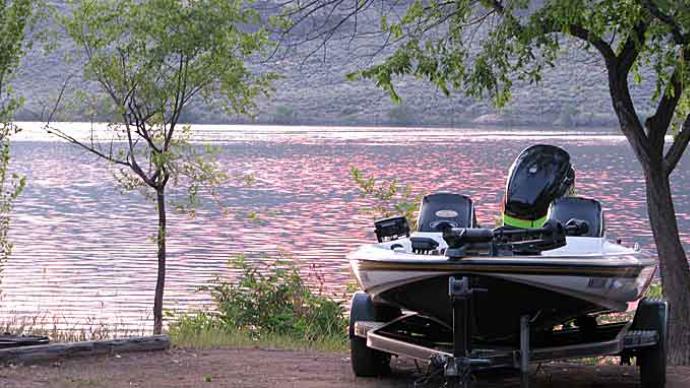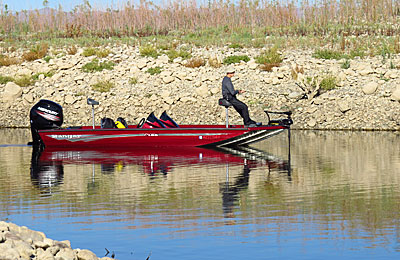
There are many reasons why you might choose to buy a small boat for bass fishing. For starters, a fully-rigged fiberglass bass boat costs upwards of $70,000 by the time you add in taxes, rigging, electronics, shallow water anchors, and destination charges. A big bass boat also occupies plenty of room, which may be a problem if you live in an apartment, especially in a big city. If there’s nowhere to park your boat, you have to pay storage charges and keep it somewhere else. Or maybe you already have a big bass boat, but on family vacations, when you’re towing the pop-up camper or travel trailer, there’s no way to tow the boat simultaneously, which means you miss out on a lot of great opportunities to fish.
It could also very well be that money and space are not a problem, but you’re just starting in bass fishing, and you’re not sure you’re ready to invest that much just yet. Aside from joining tournaments as a non-boater, what options exist for bass fishermen without bass boats?
Fortunately, there are many options- it all depends on your circumstances. If storage space is limited or you need something you can strap to the roof or the side of an RV, a folding boat might be the answer. An inflatable could fit the bill if space is even more limited than that. If you have a little more room and a way to tow it or strap it to your vehicle, a small boat like a kayak could be just what you’re looking for.
Folding Boats
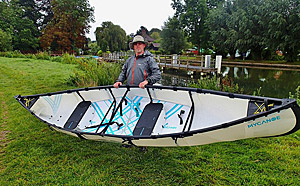
Folding boats are a super alternative to a big fishing boat. You can use a small outboard motor with a folding boat to cover a lot of water, plus you can get folding boats that are big enough for several people. They are stable enough that you can stand to fish, and there is plenty of room inside for fishing gear. Most of them fold up to about the size of a surfboard or two, so they can be strapped to the roof or the side of your pop-up or RV.
The Porta-Bote folding boat has been around for 40 years, and even older Porta-botes are working just fine. You can assemble one in less than three minutes and launch them anywhere. The hull of Porta-Bote flex but is stable to stand on, and with a 4-inch draft, you can take it just about anywhere. The downside to such a shallow draft and a light boat is that wind can move you around pretty quickly. However, you can use an outboard or a trolling motor with a Porta-bote, and a trolling motor will help you counter the wind. The boats cost around $2,600 for an 8-footer to $3,300 or so for a 14-footer, making them affordable even as a second boat. You can also add accessories such as a deck for flyfishing, a dolly, oars, RV mounts, etc. Check them out at porta-bote.com.

Another folding boat is a packable kayak called the K-Pak, consisting of a frame and a skin. It folds into its backpack so that you can take it anywhere. Once you put it together (it takes about 4 minutes), you’ve got a full-sized kayak and are ready to hit the water. It weighs 21 pounds and is a bit of a hybrid – the bottom inflates, making for a comfortable ride. This one has considerably less room for tackle, and you do have to beware of punctures, but you can’t beat it for portability. It costs less than $900, and you can see them at foldingboatco.com.
Klepper makes folding kayaks in a variety of sizes and models. Prices range from under $3,000 to over $5,600. They have many options, including outriggers, sails, and motor mounts. Depending on the model, the boats hold one to three people and assemble in under 20 minutes, thanks to their “Snap-Lock” fittings. You can see all the models and options at Klepperamerica.com.
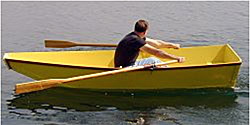
If you’re handy with tools, you can buy plans to build your folding boat out of plywood. It’s just over 10 feet long, 52 inches wide, and weighs in at 105 pounds, which you can split into two packages – 39 pounds and 66 pounds. The plans and pattern are $96, and the assembly kit for the folding part is $219. You’ll still have to buy some hardware and whatever paint or finish you decide. You can use up to a two-hp gas or electric motor with it. How cool would that be to build your boat? See more information at boatdesigns.com (enter “fold up” in the search bar).
There is also a folding canoe on kickstarter – it starts as a carrying case and transforms into a full-sized canoe in 10 minutes. It’s got plenty of room inside for two people and fishing gear, and it’s effortless to store and set up. Stabilizers are available to help with fishing, and the MyCanoe Plus, which includes oarlocks and paddles, is just $995 and ships anywhere in the world. There are no snapping parts together with this – it’s like origami. You can see all the options available at https://www.kickstarter.com/projects/mycanoe/mycanoe-performance-origami-folding-portable-canoe.
Inflatables
Inflatable boats are easily the most compact boats to store once deflated. The obvious drawback is the possibility of a puncture from a hook or a bass fin. Inflatables come in great sizes and prices – you can get anything from a float tube to a raft big enough for eight or more people.
Float tubes are ideal for small water bodies or backwaters and streams. I’ve seen guys fishing from float tubes in coves on the big reservoirs out west. They are designed for fishing, have tackle storage built in, and many have cup holders and even shoulder straps so you can backpack them into waters regular boats can’t reach. These deflate and fold down to stow in any car trunk, and you could store one in a closet or even under a bed. They are people-powered, but you can drive or hike to fish and hop in wherever you want. Your lower half will be in the water, so you’ll probably want to invest in a good pair of waders. But float tubes are incredibly affordable: Bass Pro Shops has them starting at $129. Add a pair of waders and flippers, and you can be ready to hit the water for less than $300. At that price, you can get one for everyone in the family.

Larger inflatables can be used with motors and hold much more gear. You can even get rod holders for them. Remember that the bigger the boat, the more space it takes up and the heavier it is, even when deflated. Also, inflating a huge raft can take a while. Inflatables can be had as rafts, kayaks, catamarans, pontoons, or float tubes. Depending on the size and type, you may be able to use a motor with your inflatable. You can also do a little research before you head out – many areas have places where you can rent inflatable boats by the day.
Small Boats and Kayaks
Kayaks are incredibly popular among fishermen – kayak bass tournaments are a growing phenomenon because kayaks are easy to paddle and transport, hold quite a bit of gear, and can negotiate all kinds of water that big bass boats cannot. A kayak is relatively easy to strap to the bed of a truck, car roof, the RV, or even a pop-up camper. Kayaks can be paddled, driven by pedals that power small props or paddles or even powered by wind. Some kayaks have a place to mount an electric motor. You can get a lot of bells and whistles for kayaks these days, including outriggers so you can stand to fish.
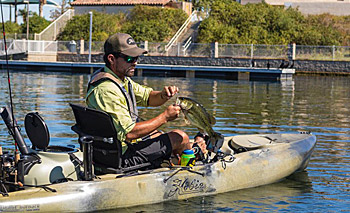
Hobie has several models specifically designed for fishing. The Mirage Pro Angler 12 weighs 129.5 pounds, fully rigged. It’s 12 feet long, 3 feet wide, powered by pedals that move flippers, and will hold 500 pounds. With a comfortable chair, cup holder, and plenty of room to store your gear, this kayak is a fisherman’s dream. You can launch it anywhere, and there’s no need to assemble anything. Just pop it in the water, get in, and fish. The Mirage Pro also comes in 14 and 17-foot models – the 17 has two seats AND two sets of pedals. You can buy a Hobie Pro Angler 12 on Amazon for $3,449.
While a kayak takes up more room than a folding boat or an inflatable, you don’t have to worry about punctures or assembly. I’ve paddled kayaks and found them stable and comfortable even when paddling all day. You can take them anywhere and even load up enough gear for a camping/fishing trip. Storing the boat might be the only problem if you are tight on storage space.
Aluminum Boats
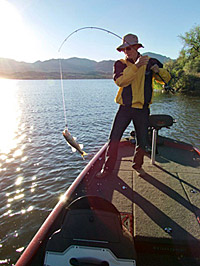
If the $70,000 price tag is the only thing keeping you out of a bass boat, maybe you should consider an aluminum bass boat. My Ranger RT188 is an 18-foot, 8-inch bass boat with all the bells and whistles: a big central rod locker, tons of locking storage, electronics, boarding ladder – the works. The only thing it doesn’t have is the whopping price tag. We took ours home for far less than half the price of a big fiberglass boat. It toodles around the lake at about 40 mph, has great livewells, and fishes beautifully. And seriously, it rides so smooth you’d swear you were in a fiberglass boat.
If tin cans spring to mind when you think of aluminum boats, you’re way off the mark when it comes to the Ranger. Virtually every cavity in this boat is filled with closed cell foam, making it incredibly safe and quiet. These boats exceed the Coast Guard specs for flotation. They’ll even stay afloat with major sections cut out. Parallel to the keel are four welds to reinforce the boat – it’s super strong, safe, and quiet. Not at all like a tin can – more like a fiberglass boat without the price tag.
There are many options for getting on the water, no matter your price range. Suppose you’re tired of fishing from shore or not being able to fish while on the road with the family; check out alternative boats. You may be surprised at how affordable and compact they can be.


